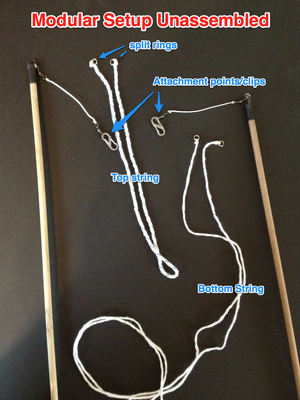Since I get a lot of inquiries both here and on the wiki's Facebook page about my personal gear, I have created this page with the gear that I generally use.
Juice
I tend to switch between guar-based juice, PEO-based juice and HEC based juice. When I used guar juice, I don't use other polymers (unless I am mixing together leftovers from a session). For PEO-based juice, I most frequently use eGoo at a variety of dilutions. With eGoo, I usually use water to concentrate ratios of 12 to 16 to 1 (which achieves water to detergent ratios of about 20:1 to 24:1). I often like "basic" PEO juice which is water and detergent (these days I prefer 20:1 if there is decent humidity) plus some PEO solution (just water and PEO) or BLM. I ph-adjust all my juice to about pH 7.6. I frequently use baking powder for the pH adjustment or a 5% citric acid solution. (See pH Adjusters).
I love HEC-based juice (especially for super giants) but use it less frequently because HEC takes more time and care to hydrate.
Loops
I use a lot of different loops.
Since 2012, I have mostly used modular loops where I clip separate top and bottom strings to my wand's attachment points (which are usually size #1 S-Biners. For small loops (48" and smaller), I often use "normal" (non-modular) loops.
I strongly favor composite tri-string loops (especially for giant bubbles) which uses different materials for the top and bottom strings. If you have not explored them, I highly recommend them,
I am constantly experimenting with different materials and different top/bottom string combinations.
Top Strings. As of Feb. 2015, my favorite top-strings tend to be made from RubberMaid mop yarn. I think my favorite is material for top strings is a full-ply length of RubberMaid Webfoot Microfiber mop yarn. I also like the RubberMaid Rayon Finish Mop Yarn (which unfortunately is no longer available in mop heads made from a single continuous length).
Bottom Strings. For bottom strings, I am still very much on the fence about what I like best -- especially for very large loops. As of Feb 2015, I very often use a single strand of soda-washed cooking twine. I purchase the twin from Bed, Bath and Beyond. Soda washing is critical for this twine. I also frequently use 1 or 2 strands of deconstructed mop yarn. The mop yarn is so absorbent that even a single strand has a lot of capacity, but may be slightly self-closing when drained. Two strands are heavy enough not to be self-closing. A two-strand bottom will not tend to fly out in the wind. I believe that more than two strands does not increase capacity though it vastly increases juice usage.
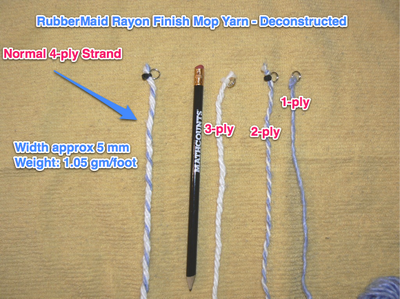
Deconstructed mop yarn. At right is the RubberMaid Finish Map yarn that I often use for top-strings. Even more often I used the RubberMaid Webfoot Microfiber Mop Yarn for the top. But, I continue to use other top-strings, too.
In 2014 and 2015, I am exploring Paton's Wool Roving and other's, too. See Wicks.
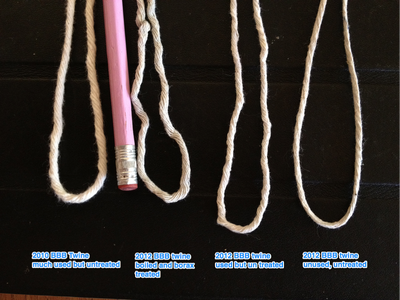
I frequently use soda-washed twine for my bottom strings
I frequently use a single strand of soda-washed twine for my bottom strings. Even though they don't hold tons of juice, they are rarely the limit the bubble size if paired with a high-capacity top-string. Many of the largest bubbles I have made have had a single strand of twine for the bottom. In 2013, I started using Procion dye (per Brian Lawrence's recommendation) in order to track my batches of twine. The dye has no impact on the capacity, but the soda-washing definitely does.
Poles
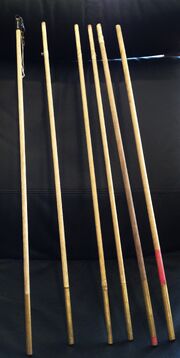
A set of 2-foot long dowel segments that fit together to make a 12-foot long pole. Edward used 4 to 6 segments to make most of the giants and supergiants seen on this site.
I mostly use homemade poles made from hardware store dowels. The quality and strength of dowels varies considerably around the country and from hardware store to hardware store. See the Pole Extensions article for details.
I also occasionally (but only rarely) use a pair of 13-foot Crappie poles purchased from Cabelas.com
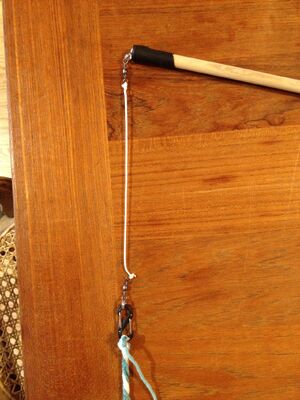
For details about how the wand is rigged see the article DIY Tri String Handles (EAS).
